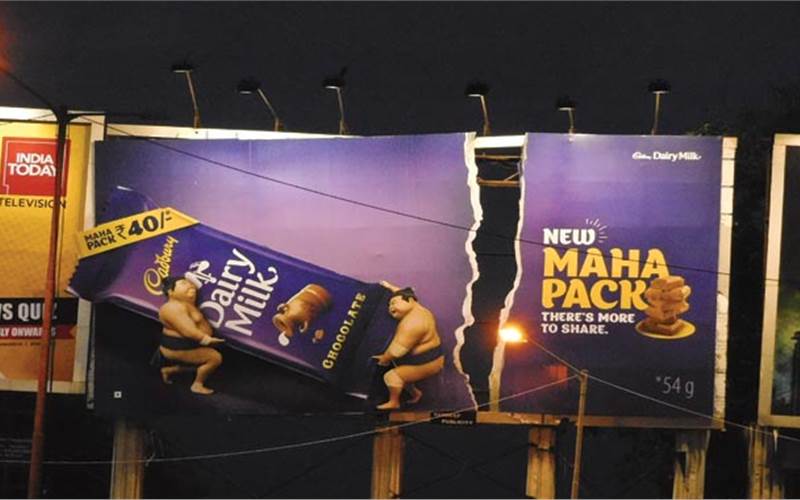How to exploit the OOH landscape
In layman terms, the main objective, perhaps the only objective, of OOH is to grab eyeballs. One of the things agencies are doing to achieve this is to mix all the available medias – it’s not just the good old billboards anymore. Now, we have unipole, billboard, back-lit, LED screen and duct panel, and at times even digital interfaces. Posterscope India, the OOH agency from Dentsu Aegis Network, seems to be doing this with aplomb. Dibyajyoti Sarma brings you two case studies from the agency whic
07 Oct 2016 | By Dibyajyoti Sarma
Considering ad spent, OOH remains largely neglected, despite being the most visible of all sources where an ad can appear. Talking about ad spend, TV rules the roost, followed by newspapers. And what was traditionally the market share of OOH, has been grabbed by proliferating digital ads. What is the OOH industry doing wrong? There is no easy answer, but we could attempt one – lack of innovation. Even today, OOH is largely the large billboards in the busy street corners.
Its time OOH evolved. Media has transformed newspapers into ePapers and television into mobile apps. Similarly, OOH must evolve to keep pace with changing times. If you think about it, there are endless possibilities where OOH can go, if we could exploit emerging technologies, such as mobility solutions like real-time location scanning, or a plain digital screen, to our advantage.
Although there has been 14% growth in OOH in 2015, traditional OOH remains a challenge. While the Rs 600-crore market of digital media attributes its success to high level of interactivity and other media mix is catching up fast, OOH in India has stalled. According to sources, only 6% of OOH is in the media mix. It’s time stakeholders convinced advertisers that OOH is an indispensable part of their consolidated media campaign.
In simple terms, OOH must focus on four points – accountability, quality, relevance and flexibility. This is a must in a country like India, and it’s a target possible to achieve. Posterscope India seems to be doing just this, utilising all the possibilities in the two campaigns presented alongside.
Case-Study I: Cadbury Maha Pack
The key objective of the campaign was to up-trade the Cadbury Dairy Milk consumer to a larger pack. The brand targeted youngsters in the age group between 13 and 24.
Posterscope’s campaign had a delivered mix of billboard, unipole, gantry, pillars, train stations, metro train and bus shelters across top 15 cities, covering more than 300 touchpoints and 500 plus media units. In addition to using the traditional OOH media formats, Posterscope took the OOH communication to another level by creating a larger-than-life Cadbury Dairy Milk Maha Pack held together by cut-outs of two sumo wrestlers on a truck. The 22-feet truck carried the huge cut-out in the peak traffic hours of Mumbai across the length and breadth to create buzz, both online and offline. This was an absolute eye-catcher for the travellers in the peak hours, creating the required impact and buzz for the brand.
Another innovation was executed at one of the busiest roads in Juhu, Mumbai, showcasing the Maha Pack, breaking the billboard into two parts (It’s so huge that the billboard cannot carry it anymore, you see!).
Haresh Nayak, regional director, Posterscope APAC, said, “This was disruptive advertising. Not only did the team go ahead and create a new media option for the brand but we also created multiple innovations highlighting the core essence of the product. The media strategy was aligned to ensure that the campaign matches the means of communication in the OOH space, within the consumer ecosystem.”
Case-Study II: Hitachi refrigerator
Hitachi’s three-door refrigerators come with ‘New French Bottom Freezer’. The refrigerators have large door pockets suitable for storage of big bottles.
The core objective of the campaign was to build awareness and thereby, increase sales. The month-long campaign was aimed at reaching out to the affluent customers. Building on the brief, Posterscope crafted a campaign that resulted in a media mix, delivering both impact and reach. The campaign has a delivered mix of unipole, billboard, back-lit premium bus shelters, LED screen and duct panel. The campaign has been implemented across top eight cities.
The campaign was designed to communicate the key brand feature of the three-door refrigerator and to build recall at points-of-purchase to accelerate consumer-purchase decisions.
The campaign, based on the brand communication, ‘Inspire the Next’, motivated the agency to come up with a one-of-its-kind innovation, where a billboard was integrated with digital. According to the agency, such an innovation was attempted for the first time in India. The technology used behind this innovation was based on ‘addressable pixel programming’, where every pixel was coded and mapped on the hoarding.
Based on the agency’s understanding of the target consumer, derived from its primary research, patented analytical tools and accumulated understanding, Posterscope zeroed in on a specific location in Delhi –Ring Road, the only point that connects South Delhi to West Delhi. It is one of Delhi’s main arterial roads that witnesses heavy traffic and market influx. This resulted in a flawless execution of the campaign and all timelines were maintained without any compromise in quality.
Haresh Nayak, regional director, Posterscope APAC, said, “We are glad to be associated with the exercise for Hitachi, ensuring the creation of high impact visibility with the widespread OOH campaign. The world is currently standing in the midst of massive technological advancements, and consumers in India are not just aware but also exposed to these evolutions while sitting at home. Therefore, the campaign that we executed had to be such that it could stand up to a world-class quality. I am glad that we have stood tall and delivered so well.”














 See All
See All